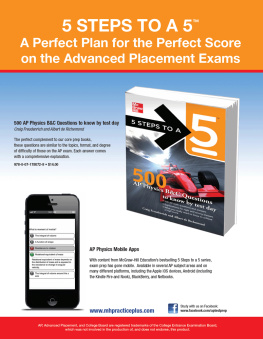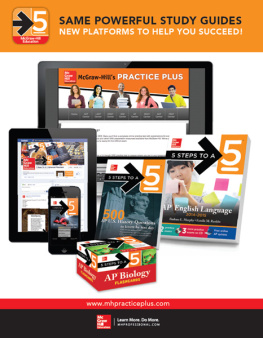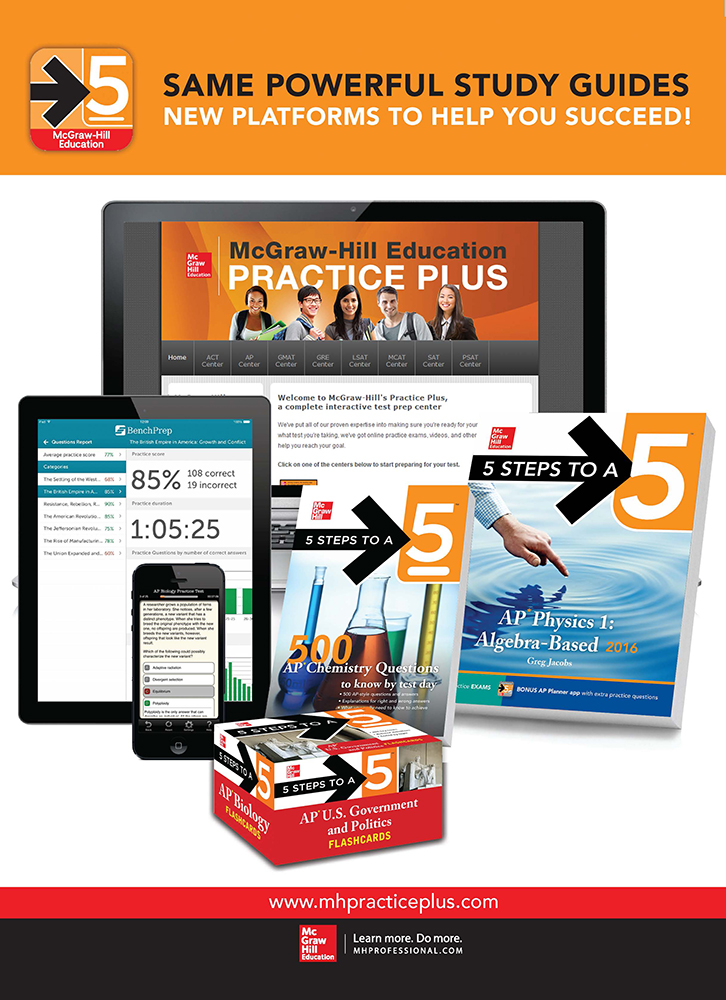Copyright 2015 by McGraw-Hill Education. All rights reserved. Except as permitted under the United States Copyright Act of 1976, no part of this publication may be reproduced or distributed in any form or by any means, or stored in a database or retrieval system, without the prior written permission of the publisher, with the exception that the program listings may be entered, stored, and executed in a computer system, but they may not be reproduced for publication.
ISBN: 978-0-07-184640-0
MHID: 0-07-184640-9
The material in this eBook also appears in the print version of this title: ISBN: 978-0-07-184639-4, MHID: 0-07-184639-5.
eBook conversion by codeMantra
Version 1.0
All trademarks are trademarks of their respective owners. Rather than put a trademark symbol after every occurrence of a trademarked name, we use names in an editorial fashion only, and to the benefit of the trademark owner, with no intention of infringement of the trademark. Where such designations appear in this book, they have been printed with initial caps.
McGraw-Hill Education eBooks are available at special quantity discounts to use as premiums and sales promotions or for use in corporate training programs. To contact a representative, please visit the Contact Us page at www.mhprofessional.com.
McGraw-Hill Education, the McGraw-Hill Education logo, 5 Steps to a 5, and related trade dress are trademarks or registered trademarks of McGraw-Hill Education and/or its affiliates in the United States and other countries and may not be used without written permission. All other trademarks are the property of their respective owners. McGraw-Hill Education is not associated with any product or vendor mentioned in this book.
AP, Advanced Placement Program, and College Board are registered trademarks of the College Entrance Examination Board, which was not involved in the production of, and does not endorse, this product.
The series editor was Grace Freedson, and the project editor was Del Franz.
Series design by Jane Tenenbaum.
TERMS OF USE
This is a copyrighted work and McGraw-Hill Education and its licensors reserve all rights in and to the work. Use of this work is subject to these terms. Except as permitted under the Copyright Act of 1976 and the right to store and retrieve one copy of the work, you may not decompile, disassemble, reverse engineer, reproduce, modify, create derivative works based upon, transmit, distribute, disseminate, sell, publish or sublicense the work or any part of it without McGraw-Hill Educations prior consent. You may use the work for your own noncommercial and personal use; any other use of the work is strictly prohibited. Your right to use the work may be terminated if you fail to comply with these terms.
THE WORK IS PROVIDED AS IS. McGRAW-HILL EDUCATION AND ITS LICENSORS MAKE NO GUARANTEES OR WARRANTIES AS TO THE ACCURACY, ADEQUACY OR COMPLETENESS OF OR RESULTS TO BE OBTAINED FROM USING THE WORK, INCLUDING ANY INFORMATION THAT CAN BE ACCESSED THROUGH THE WORK VIA HYPERLINK OR OTHERWISE, AND EXPRESSLY DISCLAIM ANY WARRANTY, EXPRESS OR IMPLIED, INCLUDING BUT NOT LIMITED TO IMPLIED WARRANTIES OF MERCHANTABILITY OR FITNESS FOR A PARTICULAR PURPOSE. McGraw-Hill Education and its licensors do not warrant or guarantee that the functions contained in the work will meet your requirements or that its operation will be uninterrupted or error free. Neither McGraw-Hill Education nor its licensors shall be liable to you or anyone else for any inaccuracy, error or omission, regardless of cause, in the work or for any damages resulting therefrom. McGraw-Hill Education has no responsibility for the content of any information accessed through the work. Under no circumstances shall McGraw-Hill Education and/or its licensors be liable for any indirect, incidental, special, punitive, consequential or similar damages that result from the use of or inability to use the work, even if any of them has been advised of the possibility of such damages. This limitation of liability shall apply to any claim or cause whatsoever whether such claim or cause arises in contract, tort or otherwise.
AP Teachers: Order your free online Teachers Manual
with teaching strategies, student activity and project ideas, and other ways to incorporate the review materials and practice tests in this 5 Steps to a 5 guide into your classroom curriculum.
Download your free Teachers Manual from:
http://www.mhprofessional.com/promo/5steps/
or scan this QR code:
ABOUT THE AUTHOR
Greg Jacobs is chairman of the science department at Woodberry Forest School, the nations premier boarding school for boys. Over the years, Greg has taught all flavors of AP physics. He is a reader and consultant for the College Board, which means he grades AP physics exams, and he runs professional development seminars for other AP teachers. Greg is president of the USAYPT, a nonprofit organization promoting physics research at the high school level. Greg was recently honored as an AP Teacher of the Year by the Siemens Foundation. Outside the classroom, Greg has coached football, baseball, and debate. He is the play-by-play voice of Woodberry sports on the Internet, calling football, baseball, soccer, and basketball games. Greg writes the prominent physics teaching blog available at www.jacobsphysics.blogspot.com.
CONTENTS
PREFACE
Why is this book different from all other AP Physics prep books?
The quality of the prep book starts with the author. Greg Jacobs has taught all versions of AP (and not-AP) physics since 1996. His hundreds of students over the years have a greater than 99 percent pass rate; more than 70 percent earn 5s. Greg has graded the exams, he has written questions that have appeared on exams, and he has taught teachers how to teach to the exams. The leading blog about physics teaching is hisJacobs Physics. (Take a look at it.) Your author isnt some med student looking for extra cash, or a no-name college professor. Greg knows what hes talking about, and the proof is in the results and feedback from his students.
AP Physics 1 emphasizes conceptual understanding over algebraic manipulation and so does this book. So many people presume that physics is about finding the right numbers to plug into the right equation. That couldnt be farther from the truth. Successful physics students can explain why they chose a specific equation. They can explain what values for each variable are reasonable, and why. They can explain the physical meaning of any mathematical manipulationhow would this problem look in the laboratory? What equipment would be used to measure these values? The AP Physics 1 exam mostly asks questions that are not about number crunching. Greg has been teaching beyond the numbers for years, and he brings his expertise in explaining complex concepts in simple language.
Your textbook is impenetrable, even to senior physics majors. This prep book is readable. Be honestwhen you read your textbook, you really just try the problems at the end of the chapter, then look back for a template of how to do those problems. Well, this books content review is structured around this very method. Greg poses example equations and talks you through them. On the way, he shows you the relevant facts and equations, as well as






